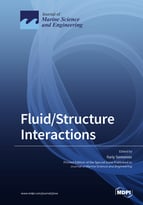Fluid/Structure Interactions
A special issue of Journal of Marine Science and Engineering (ISSN 2077-1312). This special issue belongs to the section "Ocean Engineering".
Deadline for manuscript submissions: closed (25 February 2021) | Viewed by 40402
Special Issue Editor
Interests: mathematical modelling; fluids engineering; applied and computational mathematics; fluid dynamics; nonlinear analysis; cavitation
Special Issues, Collections and Topics in MDPI journals
Special Issue Information
Dear Colleagues,
Fluid/Structure interaction is a wide multi-disciplinary topic of fluid dynamics, which is continuously developing. In the last decade, the main drivers of research in this field have been the renewable energy sector, advanced ship technology, bioengineering, activities in the Arctic Regions due to the climate change and ice melting, and deep-water resource exploration.
The purpose of the Special Issue is to collect together the most exciting experimental, theoretical, and computational studies and to provide high-quality reviewing and a rapid publication, which is the particular feature of this journal.
High-quality papers directly related to the various aspects indicated below are encouraged:
wave energy convertors;
offshore wind farms;
coastal structures;
polar engineering;
surface and submerged vehicles;
dynamics of hydraulic systems;
slamming of ships;
marine propulsors.
Dr. Yuriy SemenovGuest Editor
Manuscript Submission Information
Manuscripts should be submitted online at www.mdpi.com by registering and logging in to this website. Once you are registered, click here to go to the submission form. Manuscripts can be submitted until the deadline. All submissions that pass pre-check are peer-reviewed. Accepted papers will be published continuously in the journal (as soon as accepted) and will be listed together on the special issue website. Research articles, review articles as well as short communications are invited. For planned papers, a title and short abstract (about 100 words) can be sent to the Editorial Office for announcement on this website.
Submitted manuscripts should not have been published previously, nor be under consideration for publication elsewhere (except conference proceedings papers). All manuscripts are thoroughly refereed through a single-blind peer-review process. A guide for authors and other relevant information for submission of manuscripts is available on the Instructions for Authors page. Journal of Marine Science and Engineering is an international peer-reviewed open access monthly journal published by MDPI.
Please visit the Instructions for Authors page before submitting a manuscript. The Article Processing Charge (APC) for publication in this open access journal is 2600 CHF (Swiss Francs). Submitted papers should be well formatted and use good English. Authors may use MDPI's English editing service prior to publication or during author revisions.
Keywords
- vortex-induced vibration
- aero/hydroelasticity
- free-surface and multiphase flows
- wave-body interactions
- ice-fluid interaction
- cavitation instability
- vessel dynamics
- offshore aquaculture






